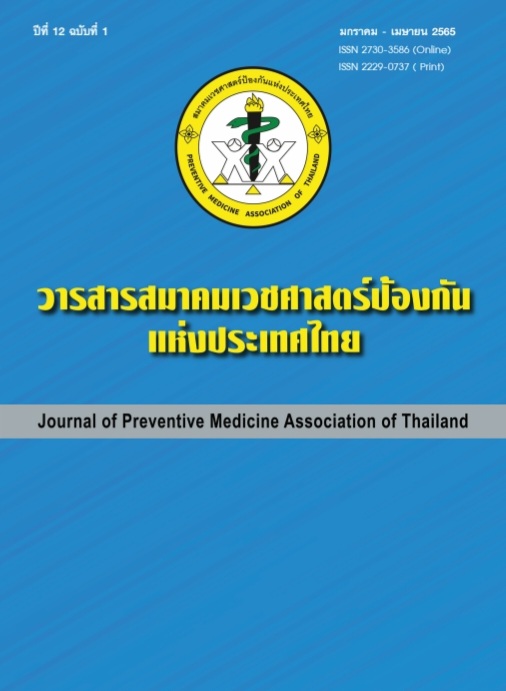Incidence of Coronavirus 2019 in Workplace after Self Evaluation of Risk Assessment and Vigilant Measures Against the Spread of Coronavirus 2019 (COVID-19), Rayong Province
Keywords:
workplace, risk assessment, vigilant measures, COVID-19Abstract
The aim of this article is to estimate incidence of Coronavirus 2019 (COVID-19) in workplace. Self-evaluation data of risk assessment following the preventive measures against the spread of COVID-19 in “New normal” lifestyle recommended by Department of Disease Control, Ministry of Public Health, were collected. These data collected from 222 industries in Rayong Province. The posted questionnaire was registered in May 2020, and data of Covid-19 infection in workplace during May 2020 to July 2021 were analyzed. The risk assessment results reported 79.7% in moderate
risk. The Incidence of COVID-19 infected cases in workplace was 9% (20 industries). Most Covid-19 infected cases were found in moderate risk industries. Identify risk by working characteristics, COVID-19 infected cases were working in low to moderate risk workplace. The industries with preventive measures against the spread of COVID-19 in workplace had lower infected cases reported than those without and significant
associated with COVID-19 infected. In those industries with infected cases reported found that only 15% of them had complete preventive measure (OR 0.22,95%CI 0.06-0.77), 15% had specific job safety (OR 0.24 ,95%CI 0.07-0.86), 40% had frequent surface area clean with disinfectant (OR 0.27,95%CI 0.10-0.69), and only 15% had periodically preventive measure adaptation to the on going situation (OR 0.24,95%CI 0.68-0.85). In conclusion, risk assessments should be done to determine the level of risk associated. And the preventive measures are necessary in order to control the spread of COVID-19 in workplace.
References
Coronaviridae Study Group of the International Committee on Tazonomy of Viruses. The species Severe acute respiratory syndrome-related coronavirus: Classifying 2019-nCoV and naming it SARS-CoV-2. Nat Microbiol 2020;5(4):536-44.
Liu Y, Ning Z, Chen Y, Guo M, Liu Y, Gali NK, et al. Aerodynamic analysis of SARS-CoV-2 in two Wuhan hospitals. Nature 2020;582:557-60.
Ingram C, Downey V, Roe M, Chen Y, Archibald M, Kallas KA, et al. COVID-19 prevention and control measures in workplace settings: a rapid review and meta-analysis. Int J Environ Res Public Health 2021;18(15):7847.
กรมควบคุมโรค กระทรวงสาธารณสุข. มาตรการการดำเนินงาน เฝ้าระวัง ป้องกัน ควบคุมโรค ติดเชื้อไวรัสโคโรนา 2019 สำหรับพัฒนา “สถานที่ทำงานต้านโควิด 19 ในฐานวิถีชีวิตใหม่ : New Normal.นนทบุรี: กรมควบคุมโรค กระทรวงสาธารณสุข; 2563.
กรมวิทยาศาสตร์การแพทย์ กระทรวงสาธรณสุข. การวินิจฉัยโรคติดเชื้อไวรัสโคโรน่า 2019. นนทบุรี: กรมวิทยาศาสตร์การแพทย์ กระทรวงสาธารณาสุข; 2563.
Bontadi D, Bergamo L, Torri P, Patanè PA, Bertoldi A, Lonardi U. Effectiveness of the measures aimed at containing Sars-cov-2 virus spreading in work settings: a survey in companies based in the Veneto region of Italy. Med Lav 2020;111(5):404-10.
Ceryes C, Robinson J, Biehl E, Wirtz AL, Barnett DJ, Neff R. Frequency of workplace controls and associations with safety perceptions among a national sample of US food retail workers during the COVID-19 pandemic. J Occup Environ Med 2021;63(7):557-64.
Ishimaru T, Nagata M, Hino A, Yamashita S, Tateishi S, Tsuji M, et al. Workplace measures against COVID-19 during the winter third wave in Japan: Company size-based differences. J Occup Health 2021;63(1):e12224.
Downloads
Published
How to Cite
Issue
Section
License
Copyright (c) 2022 Journal of Preventive Medicine Association of Thailand

This work is licensed under a Creative Commons Attribution-NonCommercial-NoDerivatives 4.0 International License.
บทความที่ลงพิมพ์ในวารสารเวชศาสตร์ป้องกันแห่งประเทศไทย ถือเป็นผลงานวิชาการ งานวิจัย วิเคราะห์ วิจารณ์ เป็นความเห็นส่วนตัวของผู้นิพนธ์ กองบรรณาธิการไม่จำเป็นต้องเห็นด้วยเสมอไปและผู้นิพนธ์จะต้องรับผิดชอบต่อบทความของตนเอง






